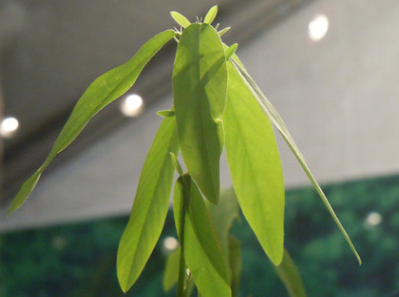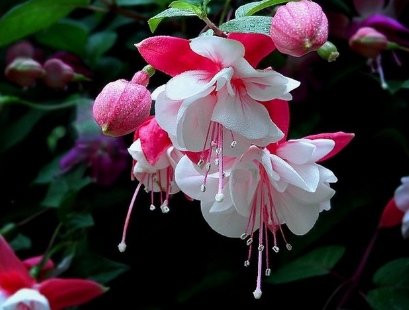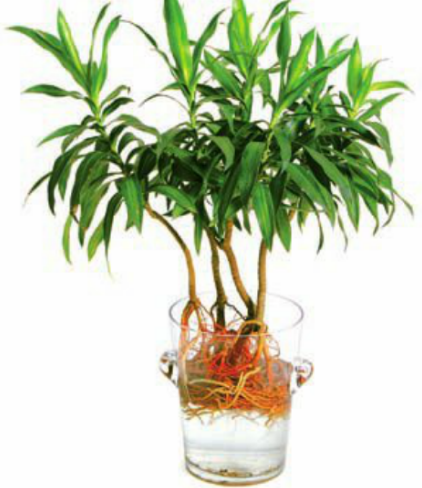Why does dancing grass dance? how do you raise bonsai?
Dance grass is an erect shrub named for its posture like a dancing girl. It grows and distributes mostly in China, Bhutan and Sri Lanka.

Why does dancing grass dance?
1. How does the grass dance
There are a large number of linear leaflets growing on both sides of the leaves of dancing grass, which are very sensitive to sound waves. When the temperature is not less than 22 ℃ and the vision is sufficient, the dancing grass stimulated by sound waves will continuously swing up and down, just like butterflies dancing their wings in the air.
2. The reasons for dancing grass dancing
Dancing grass can dance with temperature, sunshine and sound waves.
The leaflets on both sides of the dance grass dance because the cavernous tissue at the base of the petiolule is sensitive to light. In the environment of strong light at room temperature and no wind and rain, the linear leaflets on both sides of the dancing grass leaves will keep swinging, and each leaflet can complete an oval movement in half a minute, return to its original position after 180 degrees, and continue to rotate.
When the sun shines, the temperature begins to rise, the water in the plant evaporates quickly, the sponge expands, and the leaflet swings from side to side. The stronger the light, the faster the movement until all the leaves droop and close to sleep at night. When the sun goes down and the light darkens, the leaves droop, close and stick to the branches.
When it is oscillated by a song of 35-40 decibels, the sponge also shrinks, causing the leaves to wobble.
How about dancing grass? how about bonsai?
1. The soil of dancing grass bonsai
Dance grass likes loose, fertile, well-drained soil, which can be fertile sandy soil or humus soil, with rotten leaf mud as the best.
2. The lighting of dancing grass bonsai
Dance grass likes light, if the lack of light, the plant is easy to grow, become slender, thin and easy to lodge. Pay attention to increase the light, if the weather is not very good, you can often turn the flowerpot, so that all angles of the branches and leaves of the plant to receive sunlight, so that the dance grass can fully grow.
3. Watering and fertilization of dancing grass bonsai
In the budding period of dancing grass, it is necessary to keep the basin soil moist. After budding, the basin soil should be dry outside and wet inside. A little dry. The watering time is usually in the morning. If tap water is used when watering, it needs to be treated before watering. When watering, pay attention to less watering at the root of the plant, and it is best not to splash on the leaves and stems.
Dance grass has less demand for fertilizer, and the frequency of fertilization is not much. Fertilizer is generally needed in the growing period, and fertilization is also needed in order to replenish nutrients during the flowering period.
4. prevention of diseases and insect pests of dancing grass bonsai
Dancing grass is vulnerable to powdery mildew, charcoal maggot, leaf spot, root rot and other diseases. when diseases occur, the diseased branches should be cut off and destroyed. In addition, dancing grass is also vulnerable to the threat of ground tigers, powder, thrips, mites and other insect pests, which need to be controlled in time.
How to raise dancing grass bonsai
The soil of dancing grass bonsai
Dance grass likes loose, fertile, well-drained soil, which can be fertile sandy soil or humus soil, with rotten leaf mud as the best.
The light of dancing grass bonsai
Dance grass likes light, if the lack of light, the plant is easy to grow, become slender, thin and easy to lodge. Pay attention to increase the light, if the weather is not very good, you can often turn the flowerpot, so that all angles of the branches and leaves of the plant to receive sunlight, so that the dance grass can fully grow.
Watering and fertilization of dancing grass bonsai
In the budding period of dancing grass, it is necessary to keep the basin soil moist. After budding, the basin soil should be dry outside and wet inside. A little dry. The watering time is usually in the morning. If tap water is used when watering, it needs to be treated before watering. When watering, pay attention to less watering at the root of the plant, and it is best not to splash on the leaves and stems.
Dance grass has less demand for fertilizer, and the frequency of fertilization is not much. Fertilizer is generally needed in the growing period, and fertilization is also needed in order to replenish nutrients during the flowering period.
Prevention and control of diseases and insect pests of dancing grass bonsai
Dancing grass is vulnerable to powdery mildew, charcoal maggot, leaf spot, root rot and other diseases. when diseases occur, the diseased branches should be cut off and destroyed. In addition, dancing grass is also vulnerable to the threat of ground tigers, powder, thrips, mites and other insect pests, which need to be controlled in time.
[dancing grass video] Why does dancing grass dance?
Dance grass is also known as dance grass, love grass, affectionate grass, romantic grass, courtship grass, windless automatic grass and so on. Dance grass is a perennial woody plant of the genus Leguminosae, which dances when the sound reaches 70 decibels. There are many linear leaflets on both sides of the leaves of dancing grass, which are very sensitive to sound waves. When the sun shines at a temperature of no less than 22 degrees Celsius, they will swing up and down continuously when stimulated by sound waves. Like butterflies dancing with their wings in flight and girls with relaxed arms on the stage, they are called dance grass. The following editor gives a detailed answer to the question of why dancing grass dances.
[introduction to Dance Grass] Dance grass likes to grow under warm conditions and is a small shrub plant. If it is cultivated in pots, the height is 70-100cm, and if it is planted on the ground, it is 1.5-2m. There are three beautiful leaves on the petioles of each branch, and when the temperature reaches 25 degrees Celsius and the sound is 70 decibels, the two leaflets will dance around the middle leaves, giving people a clear and mysterious atmosphere. Dancing grass, which generally grows in hilly wilderness and bushes, is an endangered precious plant. It likes to grow in a sunny environment, relatively resistant to drought and barren, generally grows in hilly slopes and gully thickets, and grows above 2000m above sea level. Mainly distributed in China, India, Bhutan, Sri Lanka, Nepal and other countries, is a very unique and magical plant.
Dance grass is a kind of plant with natural dancing characteristics. it is used in horticulture and bonsai as an excellent material, and it has very high ornamental value. Dance grass is the only plant in nature that can respond to sound. According to the research of scientists, the reason for the natural dance of dance grass is that it has a lot to do with temperature, sunlight, and the induction of sound waves under certain rhythm and rhythm intensity. In the case of no wind and rain in the strong light at room temperature, the two side leaflets of dancing grass will keep swinging, and within half a minute, each leaflet can achieve the efficiency of elliptical movement. every time the leaf rotates to 180 degrees, the leaf will bounce back to its original position and dance again occasionally. Even in the middle of the night's sleep, the leaflets rotate slowly, but at a slower speed than during the day. Once in a state of sleep, the petiole will stick upward to the branch, and the leaflets will automatically droop, just like a closed one. When the dawn comes, the angle of the axil of the leaf will increase, and the leaflet will be stretched out. The dancing grass dances to the music, and it's not a real plant moving. If the light is strong or the sound wave vibration is relatively large, the dancing grass will move very fast, and the leaves will not be closed until night. The reason why the leaflet ash on the side of the dancing grass keeps dancing is the dance produced by the cavernous tissue at the base of the petiolule that is very sensitive to light. Whenever exposed to the sun, the temperature will rise, the water in the dance grass will accelerate evaporation, its sponge will expand with it, and the leaflets of the dance grass will swing left and right. The dancing grass will have a sense of sound, and when it is vibrated by a song of 35 decibels and 40 decibels, its sponge will contract, driving the small leaves to dance together. According to research by scientists, the lateral lobules rotate when the outside temperature is 20 degrees Celsius. If the temperature rises to 30 degrees Celsius, the rotation will be more active, and the rotation speed will be accelerated, its movement in the plant kingdom is very rare. Therefore, why the dancing grass can dance is still a mystery, and scientists are further studying and exploring.
More information about how perfume lilies raise black King Kong how to cultivate passionfruit with Ruixiang Desert Rose in Phnom Penh
- Prev

Hang the Golden Bell upside down, how to pick the Heart, how to maintain the four Seasons
The temperature needed to hang the golden bell upside down is different in different seasons. It grows very slowly when the summer temperature reaches 30 ℃, and wilts and dies in large numbers at 35 ℃. If the winter temperature is not lower than 5 ℃ and the weak temperature is less than 5 ℃, it is easy to suffer frost injury. So the cultivation of this plant requires special attention in summer and winter.
- Next

Lily Bamboo Aquaculture skills what to do if the leaves turn yellow
Lily bamboo, also known as short-leaf bamboo banana, likes high temperature and humid semi-shady environment. Strong negative tolerance, afraid of hot sun exposure. It has the meaning of longevity and everlasting youth. Lily bamboo how to water culture, short-leaf bamboo banana habits, like high temperature, wet semi-shade environment. Strong negative tolerance, afraid of hot sun exposure
Related
- Fuxing push coffee new agricultural production and marketing class: lack of small-scale processing plants
- Jujube rice field leisure farm deep ploughing Yilan for five years to create a space for organic food and play
- Nongyu Farm-A trial of organic papaya for brave women with advanced technology
- Four points for attention in the prevention and control of diseases and insect pests of edible fungi
- How to add nutrient solution to Edible Fungi
- Is there any good way to control edible fungus mites?
- Open Inoculation Technology of Edible Fungi
- Is there any clever way to use fertilizer for edible fungus in winter?
- What agents are used to kill the pathogens of edible fungi in the mushroom shed?
- Rapid drying of Edible Fungi

